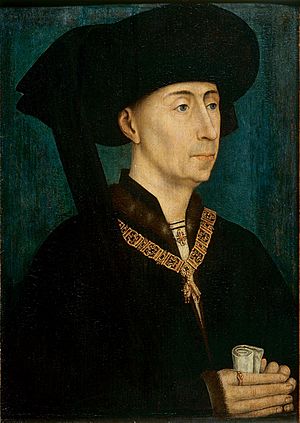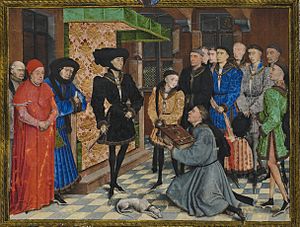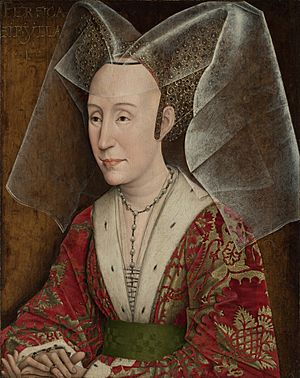Philip the Good facts for kids
Quick facts for kids Philip the Good |
|
|---|---|

Philip, wearing the collar of firesteels of the Order of the Golden Fleece he instituted, copy of a Rogier van der Weyden of c. 1450
|
|
| Duke of Burgundy | |
| Reign | 10 September 1419 – 15 June 1467 |
| Predecessor | John the Fearless |
| Successor | Charles the Bold |
| Born | 31 July 1396 Dijon, Duchy of Burgundy |
| Died | 15 June 1467 (aged 70) Bruges, Flanders, Burgundian Netherlands |
| Burial | Dijon, Burgundy |
| Spouse |
Michelle of Valois
(m. 1409; died 1422)Bonne of Artois
(m. 1424; died 1425) |
| Issue among others |
Illegitimate:
|
| House | Valois-Burgundy |
| Father | John the Fearless |
| Mother | Margaret of Bavaria |
| Signature |  |
Philip III (also known as Philip the Good) was a powerful ruler who was the Duke of Burgundy from 1419 until his death in 1467. He was born on July 31, 1396, in Dijon, France, and passed away on June 15, 1467, in Bruges. Philip was part of the House of Valois-Burgundy, a branch of the French royal family.
During his time as duke, the Burgundian State became very rich and important. It was also a leading center for arts and culture in Europe. Philip made many changes to how his lands were run. He also supported famous artists like Jan van Eyck and musicians like Gilles Binchois.
Philip played a big role in the history of the Low Countries (modern-day Belgium, Netherlands, and Luxembourg). He ruled over many areas there, including Flanders, Brabant, and Luxembourg. He was married three times and had three sons, but only one lived to be an adult. He also had many other children.
Contents
Early Life of Philip the Good
Philip was born on July 31, 1396, in Dijon, France. He was the first son of John the Fearless, who later became the Duke of Burgundy. His mother was Margaret of Bavaria. Philip was related to the French royal family.
When he was 8 years old, in 1405, Philip was given the title of Count of Charolais. In June 1409, he married Michelle of France. She was the daughter of the French King, Charles VI.
Becoming Duke and Alliances
In 1419, when Philip was 24, his father, John the Fearless, was killed. Philip then became the Duke of Burgundy. He also became the Count of Flanders and other important areas. Philip believed that Charles, the French prince, was involved in his father's murder.
Because of this, Philip joined forces with Henry V of England in 1420. This alliance was part of the larger Hundred Years' War between England and France. In 1423, Philip's sister, Anne, married an English leader, which made the alliance even stronger.
In 1430, Philip's soldiers captured Joan of Arc. She was a famous French hero. Philip then sold her to the English. The English put her on trial and she was later executed.
However, Philip's alliance with England did not last. In 1435, he signed the Treaty of Arras. This treaty made him friends with Charles VII again, and Philip recognized Charles as the King of France. Philip hoped this would make him the most important duke in France.
This decision had big effects. The French kings later saw Burgundy as a problem. They wanted to make Burgundy part of France. Philip's choice helped make the French monarchy stronger.
Expanding His Lands
Philip mostly focused on his own lands. He did not always get involved in the Hundred Years' War. But he did play a part, like when his troops captured Joan of Arc.
Philip gained many new territories during his rule:
- In 1429, he bought Namur.
- In 1432, he gained Hainault, Holland, Friesland, and Zeeland.
- In 1430, he inherited the Duchies of Brabant and Limburg.
- In 1443, he bought Luxembourg.
By 1435, Philip started calling himself the "Grand Duke of the West." This showed how powerful he had become.
In 1463, Philip gave some land to Louis XI of France. That same year, he created the first Estates-General for the Netherlands. This was a meeting of representatives from different regions. Its goal was to get money for a war against France and to make sure his son, Charles, would take over his vast lands.
Philip also stopped two rebellions in Liège in 1465 and 1467. He died in Bruges a few weeks after the second rebellion.
Court Life and Support for the Arts

Philip's court was very grand and fancy. He and his nobles loved the ideas of chivalry (the code of knights). In 1422, he turned down an offer to join the English Order of the Garter. Instead, in 1430, he created his own special group of knights called the Order of the Golden Fleece. This order was based on stories of the Knights of the Round Table. Over time, it became one of the most respected knightly orders in Europe.
Philip did not have one main capital city. He moved his court between palaces in Brussels, Bruges, and Lille. He held huge feasts and parties. Knights from his Order often traveled to take part in tournaments. In 1454, Philip planned a crusade (a religious war) against the Ottoman Empire. He announced it at a big event called the Feast of the Pheasant, but the plan never happened.
Philip's court was seen as the most amazing in Europe. It set trends in fashion and taste. This probably helped Burgundy's economy a lot. Luxury goods from Burgundy, especially from Flanders, were wanted by rich people all over Europe. Philip himself added about 600 illuminated manuscripts to his collection. This made him the most important supporter of books and writing of his time.
Philip also supported other arts. He ordered many tapestries, gold items, jewelry, and other artworks. He also had mechanical automata (moving figures) and fountains at his castle in Hesdin. During his rule, the Burgundian chapel became a top music center in Europe. Famous composers like Gilles Binchois and Guillaume Dufay were part of Philip's court.
In 1428, the artist Jan van Eyck traveled to Portugal. He painted a portrait of Infanta Isabella for Philip. She later became Philip's wife. Philip also helped build a shipyard in Bruges, which made trade grow.
Family and Children
Philip had three marriages and many children.
Marriages and Legitimate Children
Philip first married his cousin Michelle of France in June 1409. She was the daughter of King Charles VI. They had one daughter who died as a baby. Michelle passed away in 1422.
On November 30, 1424, Philip married Bonne of Artois. She was the widow of his uncle. Bonne died within a year, and they had no children.
On January 7, 1430, Philip married his third wife, Isabella of Portugal. She was the daughter of King John I of Portugal. They had three sons, but only one lived to adulthood:
- Anthony of Burgundy (1430–1432)
- Josse of Burgundy (1432)
- Charles of Burgundy (1433–1477), who became Philip's successor.
Other Children
Philip had many other children. Some of the notable ones include:
- Cornille, known as "the Great Bastard of Burgundy."
- Anthony, who also became known as "the Great Bastard of Burgundy."
- David, who became a Bishop.
- Anne, who was a governess for her niece, Mary, Duchess of Burgundy.
- Raphael, an abbot and a lover of books.
- Baudouin of Burgundy, Lord of Falais.
- Philip, who became a Bishop and Admiral.
Honours
Philip received and refused several important honours:
 Burgundian State : He was the first Grand Master and Knight of the Order of the Golden Fleece.
Burgundian State : He was the first Grand Master and Knight of the Order of the Golden Fleece. Kingdom of France – Duchy of Orléans : He was a Knight of the Order of the Porcupine.
Kingdom of France – Duchy of Orléans : He was a Knight of the Order of the Porcupine.
Refused Honours
 Kingdom of England : He refused to join the Order of the Garter.
Kingdom of England : He refused to join the Order of the Garter.
See also
 In Spanish: Felipe III de Borgoña para niños
In Spanish: Felipe III de Borgoña para niños


